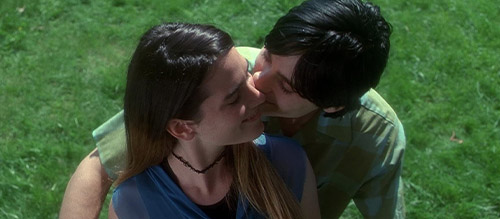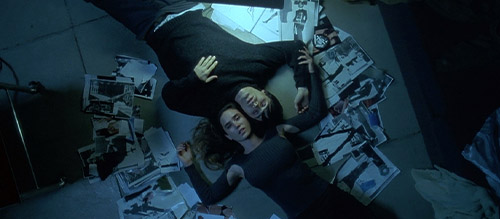Requiem for an American Dream
This article was written exclusively for The Film Magazine by Kristina Murkett.
When Requiem For A Dream was first released in US cinemas twenty years ago, it was seen as the ultimate cautionary tale against drug addiction. Roger Ebert wrote how “this travelogue of hell” should be watched by “anyone under 17 who is thinking about experimenting with drugs”; The Observer described the film as a “gruelling picture” of the “hell of drug addiction”; whilst the BBC depicted the film as the story of “the path of destruction into drugs hell.”
Of course addiction is one of the central themes of the film, and this hellish nightmare is all too real. However, to label Requiem as simply a ‘drugs movie’ is reductive; the film explores all kinds of addiction, from sugar cravings, obsessively watching television, to emotional and psychological dependence in relationships.
Yet the film is not just a condemnation of addiction, but of American society and culture as a whole; it is a requiem for the American Dream.
The first clue is in the title: a requiem means a musical composition for the departed, and what has been lost here is their dreams. Marion (Jennifer Connolly) dreams of becoming a stylist. Harry (Jared Leto) and Tyrone (Marlon Wayans) dream of becoming rich. Sara (Ellen Burstyn) dreams of being on TV and having a sense of purpose. The very first time we see Harry and Marion together they are flying paper airplanes: symbols of their fragile hopes for the future, and they even call each other their ‘dreams’.
The most powerful narcotic in the film arguably is not heroin or amphetamines, but something much deeper within our cultural psyche: our uncontrollable obsession to make something better of ourselves. For Sara it is to lose weight; for Tyrone it is to move out of the ghetto. In a flashback, a young Tyrone even says to his mother, ‘I told you mom, one day, I’ll make it.” The question the film asks though is; what does it even mean to ‘make it’, and what is the true cost?
Requiem depicts a world of instant gratification – euphoric highs, get-rich-quick schemes, fifteen minutes of fame – but the reality is that the characters end up selling far more than they gain. Sara loses her mind, Marion loses her body, Harry loses his arm and Tyrone loses his freedom; they all lose their dreams, and they all lose out on the American Dream too.
Hubert Selby, who wrote the novel the film is based on, said that the “American Dream is not only futile but self-destructive because ultimately it destroys everything and everyone involved with it. By definition it must, because it nurtures everything except those things that are important: integrity, ethics, truth, our very heart and soul. Why? The reason is simple: because life is giving, not getting.”
This condemnation of the American Dream is hugely important to our understanding of the film. Ultimately the characters are doomed by their false hopes perpetuated by a false image of success by a false culture.
Each one in turn, in their own way, is trying to fulfil some sort of internal void – whether that be caused by poverty, grief, loneliness, or just discontent – with an illusory vision of success, normally in the form of material goods. Harry and Tyrone want money; Marion wishes for her own store; whilst Sara desires to fit into her red dress, a symbol of the happiness of her youth.
Yet whilst their illusions of grandeur are not unwarranted, the problem is that they are still unobtainable. As Aronofksy said when discussing the film, “Ultimately Requiem For a Dream is about the lengths people go to escape their reality, and that, when you escape that reality, you create a hole in your present, because you’re not there. You’re chasing off a pipe dream in the future, and then you’ll use anything to fill that vacuum.”
There is a sad irony in that the characters try to fulfil their dreams with drugs, the very thing which will destroy them. By trying to escape their reality and fill the “vacuum”, they end up disconnecting from reality altogether.
Much has been made of the hip-hop montages of the film, the rapid, frantic cutting which gives the movie its messy, hurried, claustrophobic, intense feel. Whilst the editing very much focuses on the rituals of drug-taking and its physical effects, all dilating pupils and pulsing veins, the brevity of these transitions is about more than just the short-lived euphoria of their highs; it is also about the restlessness of modernity, the incessant cravings of capitalism.
In the very opening scene we see Harry trying to get into his mother’s apartment so that he can pawn her television for drug money. The split-frame highlights his egotism and isolation, but it is also interesting that everything about him is green: his t-shirt, the light he is standing under, even his skin-tone. This colour acts as a symbol for his villainy and his sickness, but most importantly his greed.
Green is of course associated with money, and money is almost everywhere in the film, from the extreme close-ups of rolled-up notes to shots of money exchanging hands, and all the way through to Harry and Sara’s surname (Goldfarb).
As Harry and Tyrone wheel the TV through the streets, they pass a fairground, another symbol of cheap thrills and short-lived pleasures, before getting high and going to a diner where, again, everything is awash with a lurid, neon green glow. The TV is an important symbol throughout the film, as it represents American culture and consumerism, but also the power it wields; it is often shot from a very low camera angle, making it look disproportionately big and threatening, a visual reminder of its status and influence in society.
Colours are also important for the other characters. Marion is very much associated with blue, representing the melancholy she feels, whilst Sara is associated with red, her desire to feel beautiful and feminine again. Despite their age gap, both Marion and Sara have an unhealthy obsession with self-image, underpinned by insecurities with their appearance. Marion in particular needs constant reassurance from Harry that she is attractive; she says to Harry that you “make me feel like a person… and I’m beautiful,” and that when other people say it it’s “meaningless.”
The novel provides more backstory for the characters: Marion comes from a well off but emotionally disengaged family, and her childhood neglect explains some of her dependence on Harry. The novel also goes into much more detail about the squalid poverty in which Harry and Tyrone live (there are literally rotting corpses in their apartment block), which again highlights the failure of the American Dream and their desperation to get rich by any means possible.
Selby writes in the novel, “to believe that getting stuff is the purpose and aim of life is madness,” but the characters do so anyway. They turn to drugs out of desperation and isolation, but also out of a failure to connect deeply with one another. One of the most poignant scenes in the film is when Sara explains to Harry that she feels “alone and old” but that being on TV is a “reason to get up in the morning… to lose weight, to fit in the red dress. It’s a reason to smile.”
The film, therefore, is about what happens when consumption replaces connection, and materialism replaces meaningful relationships. All of the characters are hooked on capitalism, the need to consume – whether that be food, money, clothes, drugs, television – until it ends up consuming them.
At the end of the film, after Marion has degraded herself, she opens the door to her apartment and sees her designs littered all over the floor, a heart-breaking reminder of her scattered dreams and all that has been lost. In her desire for commodities, she has ended up commodifying herself, and the film’s bleak ending is not just a damning indictment of drugs, but of the depressing nature of modernity altogether.
Written by Kristina Murkett
Recommended for you: Every Darren Aronofsky Directed Film Ranked
You can support Kristina Murkett in the following places:
Instagram – @cultureinthetimeofcorona
Twitter – @kristinamurkett





